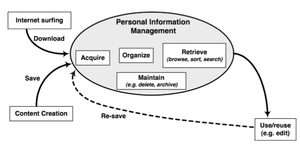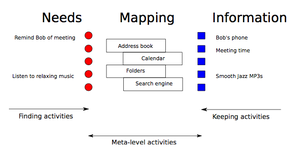Difference between revisions of "PIM frameworks"
| Line 32: | Line 32: | ||
The first group of activities is focused on the flow from information to our needs and the second group on the flow from our needs to information. All other activities support both flows as can be seen in Figure 2.<ref name="jonesteevan">William Jones and James Teevan, editors. Personal Information Management. University of Washington Press, 2007</ref> | The first group of activities is focused on the flow from information to our needs and the second group on the flow from our needs to information. All other activities support both flows as can be seen in Figure 2.<ref name="jonesteevan">William Jones and James Teevan, editors. Personal Information Management. University of Washington Press, 2007</ref> | ||
| − | + | Authors also explain these activities in more detailes: | |
| − | '''Information | + | '''Information seeking''': activities directed towards accessing information to satisfy our need or goals. Consider writing a paper: we have to find relevant papers of the subject and all activities involved in searching and finding these paper fall in this category. |
| − | '''Information Maintaining''': decisions and actions about composition and preservation of personal information collection. Consider references from example above: we have to decide which new items are going in a collection, which have leave it, how to back up | + | '''Information keeping''': decisions and actions about an information item currently in consideration that affect later retrieval. This simply means that we have to decide either to discard information or to keep in and how to keep it. Consider the above example of papers: we visit many web pages with papers and for each one we decide to leave it (discard it because it is not relevant or we think we will easily find it in the future), but some web pages are of great interest (for a paper) and we save them as web bookmarks, print them, save them in a special reference format (e.g. bibtex) ... These activities happen very often and focus is on one information item. |
| + | |||
| + | '''Refinding information''': the process of finding information that has been seen before. | ||
| + | |||
| + | '''Information organizing''': decisions and actions about information schema for a collection of information items. This means that we have to decide how to organize a personal information collection to make sense to us. Consider writing a paper: we have to organize references, have to decide on a format (e.g. Bibtex), decide on a software (e.g. BibDesk), decide how to name references (e.g. author's last name, year and first word of a title: jones2008personal, structure, tag, annotate ... These activities happen sporadically and their focus is on collection. | ||
| + | |||
| + | '''Information Maintaining''': decisions and actions about composition and preservation of personal information collection. Consider references from example above: we have to decide which new items are going in a collection, which have leave it, how to back up the collection ... These activities preserve the state and nature of a collection to serve us. Focus is again on a collection. | ||
==Matjaž Kljun== | ==Matjaž Kljun== | ||
Revision as of 01:18, 2 August 2010
Deborah Barreau
To understand how PIM is performed, Deborah Barreau tried to dismember it and so divided it in 5 sub- activities:[1]
- Acquisition: deciding which information will be included in information space, defining, la- belling and grouping information.
- Organization and Storage: classifying, naming, grouping and placing information for later retrieval.
- Maintenance: updating out-of-date information, backing up information, moving or deleting information from information space.
- Retrieval: process of finding information for reuse and • Output: visualizing the information space based on users’ needs and objectives.
Richard Boardman
Barreau's classification of PIM activities was a basis for Richard Boardman’s classification. Boardman argued that updating information content cannot be a part of PIM, as it deals with content of information items. He also argued that visualizing is done by computers (not users) and that visualization is present in all sub-activities.[2] He describes four PIM sub-activities as:
- Acquisition: naming and/or (deciding of a) placement in information space.
- Organization: placing information items, renaming, moving and creating new folders.
- Maintenance: backing up and deleting information from information space.
- Retrieval: browsing, sorting and searching for information.
William Jones and James Teevan
Jones and Teevan devided all PIM activities in three main groups that support our needs in correlation to information:
- Keeping activities: decisions focused on a single information item about the future needs and future availability.
- (Re)finding activities: driven by our needs for information in PSI.
- Meta-level activities: maintenance (composition and preservation) and organization (selection and implementation of a scheme) of the PIC within PSI, managing privacy, evaluating PSI, making sense of information and information distribution.
The first group of activities is focused on the flow from information to our needs and the second group on the flow from our needs to information. All other activities support both flows as can be seen in Figure 2.[3]
Authors also explain these activities in more detailes:
Information seeking: activities directed towards accessing information to satisfy our need or goals. Consider writing a paper: we have to find relevant papers of the subject and all activities involved in searching and finding these paper fall in this category.
Information keeping: decisions and actions about an information item currently in consideration that affect later retrieval. This simply means that we have to decide either to discard information or to keep in and how to keep it. Consider the above example of papers: we visit many web pages with papers and for each one we decide to leave it (discard it because it is not relevant or we think we will easily find it in the future), but some web pages are of great interest (for a paper) and we save them as web bookmarks, print them, save them in a special reference format (e.g. bibtex) ... These activities happen very often and focus is on one information item.
Refinding information: the process of finding information that has been seen before.
Information organizing: decisions and actions about information schema for a collection of information items. This means that we have to decide how to organize a personal information collection to make sense to us. Consider writing a paper: we have to organize references, have to decide on a format (e.g. Bibtex), decide on a software (e.g. BibDesk), decide how to name references (e.g. author's last name, year and first word of a title: jones2008personal, structure, tag, annotate ... These activities happen sporadically and their focus is on collection.
Information Maintaining: decisions and actions about composition and preservation of personal information collection. Consider references from example above: we have to decide which new items are going in a collection, which have leave it, how to back up the collection ... These activities preserve the state and nature of a collection to serve us. Focus is again on a collection.
Matjaž Kljun
a framework of keeping activities only
CEO model
http://portal.acm.org/citation.cfm?id=1277989
http://www.cs.ubc.ca/~mike/master.pdf (pages 96, 109)
Notes
- ↑ Deborah Barreau, Context as a factor in personal information management systems, Journal of the American Society for Information Science, 5/46, 1995
- ↑ Richard Boardman, 2004, Improving Tool Support for Personal Information Management, Doctoral dissertation, Imperial College, London
- ↑ William Jones and James Teevan, editors. Personal Information Management. University of Washington Press, 2007

